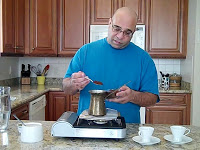

Like so many adult indulgences, Armenian coffee is an acquired taste — and I’m glad I finally acquired it, although it’s only an occasional treat now because I managed to consume about four lifetimes’ worth of caffeine during my years in the newspaper business.
Sadly, I squandered my ration by guzzling mug after mug of weak and tasteless American coffee made in machines where the water and coffee grounds pass by each other like strangers on fast-moving trains, never even getting friendly much less intimate.
Properly made, Armenian coffee demands a bit more time and all of your attention. The result is definitely worthwhile.
Truth in brewing: Everyone I knew as a kid, including my father, called it Turkish coffee. There’s no point arguing about whether Armenians or Turks invented it because we’d both lose. Coffee was most likely brought to the Near East by the Arabs, who carried the beans from North Africa.
The common element in coffee from Greece to the Middle East is that the beans are ground so finely that they turn nearly to powder. If you can’t find the proper grind in a Middle Eastern store, you need to grind your own with a device that can produce the right consistency.
Sts. Vartanantz Day is a moveable celebration on the Armenian Church calendar. This year it…
Just in time for soup season, Christine Datian offers The Armenian Kitchen her recipe for…
I don’t know about you, but in our family, we’re all about tradition when…
It’s that time of year again! St. Sarkis Day, the moveable feast day on the…
Way back in 2010 Ara Kassabian shared his family’s recipe for Nevik with The Armenian…
With Thanksgiving Day just hours away, I thought I’d share a few of our favorite,…
This website uses cookies. find out more.
View Comments
Back in the day when there was a Yugoslavia, we took a Yugoslavian freighter across the Atlantic. The crew served what they called "Turkish coffee" as opposed to "American coffee." The Turkish coffee was darker and richer than the American (which was still very strong and black for our taste). But the Turkish coffee did not have grounds or any kind of residue. Perhaps they filtered it?
I don't know why anyone would strain the coffee, unless it's a local custom. Has anyone else heard of this?
The video is wonderful. I felt like I was experiencing the whole coffee experience -- minus the wonderul aroma.
I do this all the time with my great Grandparents' old coffee grinder. A brass one they brought with them from Turkey into Syria (and eventually to Canada)!
greetings fellow armenians.
perhaps i missed this somewhere in this blogs.
the ingrediants in armenian coffee. just incase i did here is my grandmothers way of doing armenian coffee (soorj). my grandmother bought the coffe beans raw (green)they were cheeper if you bought them that way. then roasted them till almost brown/black but not black then its bitter. after grinding it into powder, she then added spices to it. cardamom main spice in armenian coffee, tiny pinch of baharat (allspaice) and (not all the time)pinch of cinnamon, then she made the coffee as shown in douglas's video. sorry for the misspelling. hope this helps.
menak paree.
shant g. meeroian
After reading this I MUST have some now. Next step is a trip to the store for the ingredients. I absolutely love your website. I'm far removed geographically from Armenian family and ethnic stores here in Northeast PA...but for a trip to Jersey or NYC. Thank you so much for bringing all these recipes to life in my kitchen.
We're so glad to be of assistance! If you have any special requests, we'll do our best to fulfill them.
I can't wait to try this, I love Armenian coffee!
ha ha :)) but this is Turkish coffee.. Why armenians say that all things are armenian??
Why do turks think everything is there's I don't know - You turkish people are cruel.